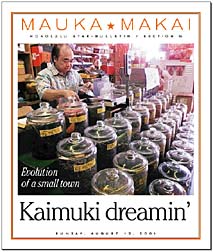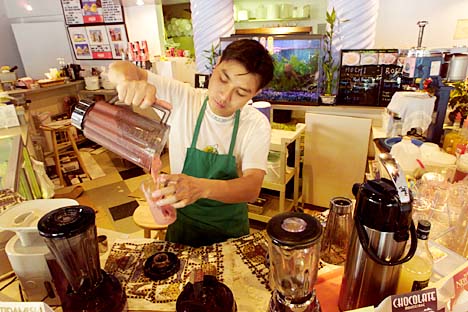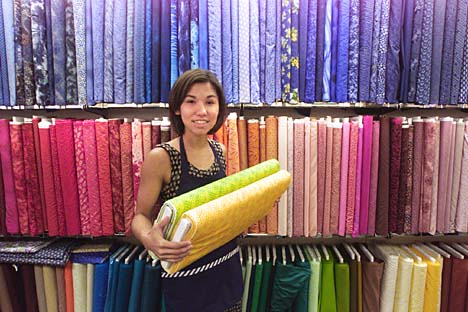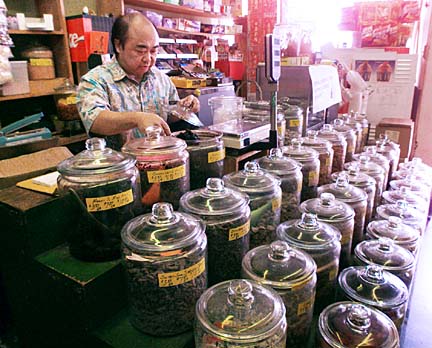

[ MAUKA MAKAI ]

Keeping pace in THERE'S AN INSCRIPTION in concrete in front of the entryway that serves both Azteca Mexican restaurant and Gecko Books and Comics on Waialae Avenue in Kaimuki. It reads: "C.S. Crane, Mayor Honolulu, A Dream Come True, Tuck Yee Yap, 9/1/38." It marked a time when a politician and a leading businessman could realize a dream of nuturing a community in what was considered "the sticks" during King Lunalilo's reign.
cozy Kaimuki
A nostalgia-rich district
searches for a cutting-edge identityCOVER STORY
Gary C.W. Chun
gchun@starbulletin.com

The question now before the people who work in one of Oahu's oldest neighborhoods is whether that dream is still vital after decades of economic doldrums.How the business district will fare in the near future is of concern to the small-time owners whose dreams inhabit this well-traveled bit of real estate, their storefronts a marked contrast between old and new approaches.
My neighborhood memories begin at Ninth Avenue, just before Waialae Avenue stretches up the district's hill (the elevation due to the lava flow that emanated from neighboring Maunalani Heights). Where once a drugstore stood next to the uniquely shaped Circle Jade apartment building -- where I lived with my family during my teenage years -- there is now an upscale French bakery flanked by two simple outdoor produce stands. And the Circle Jade, the district's one and only high-rise, has for years just been jade in name, its distinctive green shading replaced years ago by a rather unattractive beige.

From Nonth Avenue up to the hill's crest at Koko Head Avenue, the business district retains the flavor of a comfortable small town that's slowly evolving, a water-starved area that turned into a burgeoning community in the '30s, once a reservoir was able to pump water into the area. Plans have been afoot to make marked "improvements," starting from around the area of the closed-down Queen Theatre, to make it more "pedestrian-friendly."
Roots of the ti
The nonprofit Greater East Honolulu Community Alliance, a volunteer organization made up of Kaimuki, Palolo, Kapahulu and Waikiki residents and business people, with the political help of the districts' City Councilman Duke Bainum, has plans for "beautification.""There are plans for Kaimuki to have the sidewalks widened, put down planters, more use of the trolleys, too, and lampposts designed with hooks for streamers that will decorate the annual Christmas parade," said alliance member and tour guide Ginny Meade.
The "family fun free day" promotion this June took steps to publicize the convenience for both residents and tourists of using the city-subsidized trolley system that started in August of last year. Live Hawaiian music was played on the crowded trolleys as merchants offered specials to help lure additional business that Saturday.

There were also walking tours offered during the morning and early afternoon hours for the curious. Robert Takane, a small and still spry longtime resident of the area, led what was billed as a "historic walk," but he'd be the first to admit that the bulk of what he related was small-kid-time recollections and stories, authentic or not.An old Hawaii Visitors Bureau sign in front of the library on Koko Head Avenue shows the original Hawaiian spelling and pronunciation of the area's name. The literal translation of "Ka-imu-ki" is "the oven leaf," or baking the roots of the ti plant. Takane also mentioned other variants of the name, with another version meaning "swirling wind," felt to better effect in Christmas Tree Park directly behind the fire station, with its distinctive tower originally used for hanging the long, wet canvas hoses after use. A third, more pulpy story is that it was the name of an infamous highwayman (if such a description is apt for ancient Hawaii) who used to come down from the hills to prey on villagers.
Takane regaled his small group with stories of growing up in Kaimuki from the '30s on: How the pavilion in Kaimuki Park was used for political rallies during the years of the territory, with politicians exhorting the gathering to give them their vote come Election Day, and how there used to be a Japanese-language school behind the park's tennis courts on 10th Avenue, where "we learned to respect our elders and paid $1 a month for classes," big money in those days.
Community fabric
Right behind the Central Pacific Bank in the Isoshima Building is one of the oldest family-owned businesses to remain in Kaimuki. Kaimuki Dry Goods -- along with Harry's Music Store -- has been a 50-plus-year staple in the area.While Harry's has always been in the same location, it's now a relatively quiet operation, but I have many fond memories of the store from my own development as a music writer. (The first three rock records I conscientiously bought to start my "career" were from that store: the Grateful Dead's "Workingman's Dead"; the first solo album of the group's guitar avatar, Jerry Garcia; and the debut of San Francisco's It's a Beautiful Day.)
Kaimuki Dry Goods, on the other hand, moved from the current First Hawaiian Bank location up the hill to the Isoshima Building 25 years ago.

"It's been challenging to keep the business going over the years," says DeeDee Miyashiro, manager of the still family-owned and independent store. "It's still a fashion fabric store, even though the industry has changed to predominantly serve quilters. But thankfully we've established a regular client base that comes from all over the world, and we get Japanese customers from Waikiki who see our advertisements in the hotel magazines."Surrounded by bolts of every fabric imaginable, Miyashiro said that Ala Moana Center once asked her family to expand to the mega-shopping mall, but they decided against expanding for reasons of overhead. "Multiple stores haven't seemed to work overall," she said.
The dry-goods business is helped by the Kaimuki trolley, she said, as this experiment-in-progress is distinctly reminiscent of the streetcar era, when Honolulu Rapid Transit streetcars began running (around 1903), open-air cars with running boards on either side.

Takane said that there would be a driver and a token collector (the fare was 5 cents), with boys staying out of reach of the collector by first trying to get a free ride on the boards, jumping off when approached by the collector, running to keep up with the car and then jumping back on.Back around his own childhood in the mid-'30s, Takane remembered, the Tanoue Building across the street from the park had a saimin stand, with pushcarts offering up the Japanese noodle dish "for 20 cents and BBQ sticks for 10 cents," a popular gathering after football games at the old Honolulu Stadium. Renamed Nobu's Park Center Building, the Tanoue saimin stand has morphed into Kaimuki Saimin & Deli, offering "local style foods and okazuya," although the decorative red lanterns of the previous business still hang from the ceiling in deference to tradition.
Shear comfort
Right across the building's small driveway is Harold Nakamoto's barber shop, one that he ran with his late wife and which still bears her name on the window. Alice's Barber Shop has been there for 37 years, ever since the couple moved from the Kalihi area in 1964. "Kaimuki's a good community, a well-established community," said the barber, who still uses big, clanky shears on his customers amidst the comfy clutter of the small shop.Nakamoto's old-school approach to cutting hair is quite different from that employed at Rick Hoo's Parkside Salon in the 11th Avenue Atrium, a renovated, pastel-colored stucco-style building that used to house the Aina Haina garden nursery.
"Ever since the renovation, business has been picking up," Hoo said in his spaciously stylish salon. "The impetus is up and local people are rediscovering Kaimuki. The trolley coming through has helped out, along with top-notch restaurants in the area, like Cafe Laufer, Hale Vietnam and Big City Diner."
While Hoo is of a younger generation compared to someone like Nakamoto or Takane, he remembers old Kaimuki of the '50s and '60s as a veritable mecca (in fact, "my uncle had his own store across the way").

He sees the current development plans for Kaimuki as comparable to those done for the old San Diego district. Hoo wanted so much to be a part of the city's plans for the district that he moved his salon for the fourth time since he went into business."The atrium is designed in line with the feng shui philosophy," said Hoo, although he offhandedly mentions that the area seems to be filled with what he calls "harmless apparitions," which is apparently why a Chinese seafood restaurant foundered in the old Kaimuki Cue space, the cooks refusing to work side by side with restless spirits.
"I've been in business for over 20 years," Hoo said, "and this is really exciting. I've been in this new location since November, going for more the personalized, mainland approach."
The only problem Hoo sees, and it's one that's shared among all businesses in Kaimuki and a point of concern with the alliance, is "a shortage of parking, especially during the early evening and lunchtime."
Movie memories
We work our way up the hill as Takane tells us of the two neighborhood theaters, the Queen, owned by Royal Theaters, and the Kaimuki, which Consolidated Theaters once ran at the top of the hill where the 3660 business building is now. In its heyday the Queen regularly screened action/adventure serials for kids. The theater would have keno games every Thursday night after the early evening showings, "with a line that went down the block," Takane remembers.Talking about those two theaters brought back my own formative movie memories, especially at the Queen. I remember feeling a bit sad (and curious!) when the place became an adult film theater in its waning days, and later, when rock bands played on the now-empty screen stage before its closing (the heavy-metal band Megadeth was the last thing advertised on its marquee). While the Kaimuki Theatre was known for a balcony tailor-made for make-out sessions, my one distinct memory is of a sleazy B-grade black-and-white flick that was part of a triple bill.
It was titled "The Molesters." And in my naive way, I thought "Neat! A monster movie!" You know, "mole-sters." It was only when I saw the photo of a scantily clad woman posing before a nondescript living room curtain and read the poster's lurid text that I realized that this was way beyond my childish understanding.
Across the street, Liliuokalani School used to be housed in an ornate old building from 1912 (there's still a cornerstone marking the date). Takane attended that school, back when it included intermediate students and fielded a football team that would play at Honolulu Stadium in its pre-"Termite Palace" days.
Going makai on Koko Head Avenue, behind the fire station, is Kaimuki Reservoir Park, first established 10 years ago. Offering a vista of the east side of the island (and the site of UH's astronomy facility back in 1910), the more commonly known Christmas Tree Park is a popular make-out spot at night. Under the glare of the sun, the influence of the evening's activities is well evident beyond the low stone wall along the mauka side, with beer cans and bottles littering the hillside.
Takane tells us of the carnation farms that used to cover portions of Maunalani Heights, and of "going up Wilhelmina Rise to pick mountain apples with a basket made of ti leaves and stealing sugar pineapple from private yards."
You can still see the remnants of a reservoir that pumped water from the Kapahulu station that helped the development of the surrounding neighborhood, "where you could buy five acres for $400-$500," said Takane.
"When the H-1 freeway construction started, it displaced a lot of families, as it went down to the entrance of Kapahulu."
Hidden shops
While there's a sense of nostalgia and better-days-long-gone at the end of Takane's tour, Ginny Meade's alliance-boosting tour is filled with optimism and support for the merchants."Continuing community empowerment" is the group's catch phrase, as Meade leads her flock through what she considers the neat, sometimes hidden shops of Kaimuki, both old and new. There's Kwong On on the mauka side of Waialae at the top of the hill, a Chinese merchandise shop that has a popular food and sweets takeout service. Flowers by the Spinning W.E.B. on 12th Avenue cheerfully gives out free roses to the group. The group ducks into Prosperity Corner, a self-described "metaphysical gift shop" that has a faux-fantasy castle facade painted on its exterior.
In the meantime, just next door, Gordon Tam and his son Garrett work away in their little shoe repair shop, representing 70-plus years in the business and a separate reality from Prosperity Corner.
Garrett represents the third generation of Tams in the shoe repair business, one that Gordon's father started in the early '30s. Tam talks about the family shop's history in the area, remembering that it used to be in the location where the popular crafts store Bead It! is now, before termite damage forced their short-distance move.

Tam is definitely old school. He and his son do all the work, using the sturdy, original machinery his father used to repair the many shoes and pieces of luggage that have passed through their skilled hands over the decades.He mentions that his brother Leonard is part of the Kaimuki Neighborhood Board, and wonders how the planned work outside on the street will affect the small businesses the alliance is trying to rally.
His suspicious take on the changes reflects his old-time status. "The 'improvement' is going to hurt some of the businesses," he quietly says. "I hear there are plans to narrow the street, plant trees ... all this was supposed to have started. I think the original idea was some kind of mini-park idea, but now I hear they want to make it like Kahala, with speed bumps laid out on the street."
Close to the tour's end, Councilman Bainum, who with his wife was doing some meet-and-greet campaigning of his own, made it a point to meet Meade's group to press the flesh and give her a lei of appreciation.
Treading water
There's obviously a lot at stake in Kaimuki's future, as well as Kapahulu, Waikiki and all the other neighborhoods on this crowded island that have their own business areas filled with small-shop owners looking to keep their collective heads above water.They're all trying to make a buck with a special touch by offering something the public wants, whether it be tapioca drinks, locally turned art pieces and handicrafts, the best variety of cracked seed or fine ethnic dining.
Until then, that "dream come true" written in concrete may fade as the unique distinctions of our neighborhoods make way for consensus city planning. Whether sidewalks get larger or streets get smaller depends on whether you come from the perspective of the reticent business owner or the community planner. Is the glass half full or half empty?
Click for online
calendars and events.